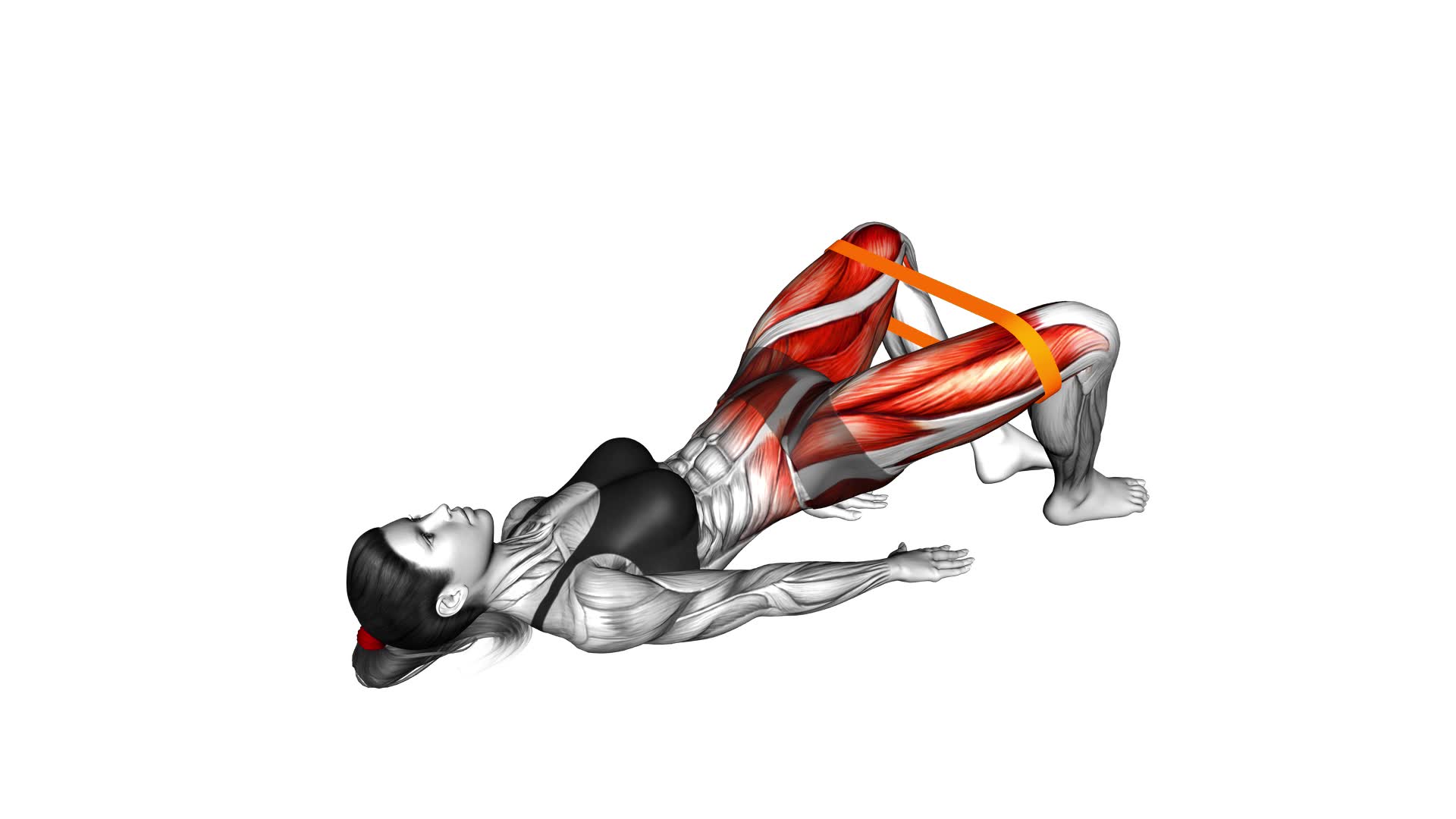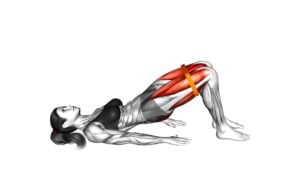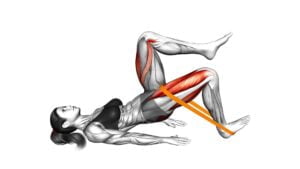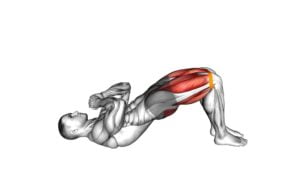Resistance Band Glute Bridge Abduction (female) – Video Exercise Guide & Tips

Get ready to take your glute workouts to the next level with resistance band glute bridge abduction.
Watch This Exercise Video
In this video exercise guide, you'll learn how to properly perform this targeted exercise to strengthen and tone your glutes.
With variations for advanced levels, you can challenge yourself and see even better results.
Avoid common mistakes and maximize your workout by following the tips provided.
Let's get started and achieve those strong and sculpted glutes you've always wanted.
Key Takeaways
- Resistance band glute bridge abduction effectively targets and activates the glute muscles
- Proper form and technique, such as maintaining a neutral spine and engaging core muscles, are important for maximizing the benefits of this exercise
- Gradually increasing resistance and incorporating variations for advanced levels can help improve strength and results
- Avoiding common mistakes like allowing knees to cave in or arching the lower back is crucial for proper execution of the exercise.
Benefits of Resistance Band Glute Bridge Abduction
Discover the numerous benefits you can achieve by incorporating resistance band glute bridge abduction into your workout routine. This exercise specifically targets your glute muscles and helps to activate them effectively. By using a resistance band, you provide additional resistance and challenge to your glutes, resulting in increased muscle activation. This is crucial for developing and strengthening your glute muscles.
Resistance band glute bridge abduction also offers injury prevention benefits. By engaging your glute muscles, you can improve hip stability and alignment. This helps to reduce the risk of injuries, such as strains or imbalances, that can occur during other exercises or everyday activities.
Furthermore, resistance band glute bridge abduction helps to improve your overall lower body strength and stability. It not only works your glutes but also engages your core, hamstrings, and hip muscles. By incorporating this exercise into your regular routine, you can enhance your athletic performance and functional movement patterns.
Incorporating resistance band glute bridge abduction into your workout routine is an efficient way to target and activate your glute muscles while also preventing injuries. By consistently performing this exercise, you can build strength, stability, and improve overall lower body function.
Proper Form and Technique
To perform the resistance band glute bridge abduction exercise correctly, position yourself on the floor with your resistance band securely wrapped around your legs just above your knees. Here are some tips to ensure proper form and technique:
- Maintain a neutral spine: Keep your back straight and avoid arching or rounding it during the exercise. This will help target your glutes effectively and prevent strain on your lower back.
- Engage your core: Before lifting your hips off the floor, engage your core muscles by drawing your belly button in towards your spine. This will provide stability and support throughout the movement.
- Squeeze your glutes: As you lift your hips, focus on squeezing your glutes at the top of the movement. This will maximize the activation of your glute muscles and help you get the most out of the exercise.
Common misconceptions:
- Many people mistakenly believe that this exercise only targets the glutes. However, it also engages the hamstrings and lower back muscles.
- Some people may think that using a heavier resistance band will yield better results. However, it's important to choose a resistance band that allows you to maintain proper form and complete the exercise with control.
Modifications for beginners:
- If you're new to this exercise, you can start by using a lighter resistance band or even performing the movement without a band. As you gain strength and confidence, you can gradually increase the resistance.
Variations for Advanced Level
For advanced level variations, you can try incorporating single-leg movements into the resistance band glute bridge abduction exercise. This will increase the difficulty and challenge your glute muscles even further.
To perform this modification, start by lying on your back with your knees bent and feet flat on the ground. Place the resistance band around your thighs, just above your knees.
Lift one leg off the ground, extending it straight in front of you. Engage your glutes and core, and then lift your hips off the ground, pushing against the resistance band as you do so. Hold the position for a few seconds, then lower your hips back down. Repeat on the other leg.
This exercise targets your glute muscles and also works your core and hip muscles. It's important to maintain proper form and control throughout the movement to prevent injury. Remember to breathe steadily and keep your core engaged.
As you get stronger, you can increase the resistance of the band or perform more repetitions to continue challenging yourself.
Common Mistakes to Avoid
To avoid common mistakes and maximize the effectiveness of the resistance band glute bridge abduction exercise, focus on maintaining proper form and control throughout the movement. Here are three common mistakes to avoid and tips to ensure proper technique:
- Allowing the knees to cave in: When performing the glute bridge abduction, it's important to keep your knees in line with your hips and feet. Avoid letting your knees collapse inward as this can put unnecessary strain on your knees and reduce the activation of your glute muscles. Instead, focus on pushing your knees outwards against the resistance band.
- Arching the lower back: Another common mistake is arching the lower back during the exercise. This can lead to lower back pain and take away from the effectiveness of the movement. To maintain proper form, engage your core and keep your pelvis in a neutral position throughout the exercise. Imagine pressing your lower back into the floor or mat.
- Rushing the movement: It's important to perform the glute bridge abduction exercise in a controlled manner. Avoid rushing through the movement or using momentum to lift your hips. Instead, focus on squeezing your glutes and using the resistance band to lift your hips up, pause for a moment at the top, and then lower down with control.
Tips for Maximizing Results
To maximize your results, focus on incorporating progressive overload into your resistance band glute bridge abduction routine. Progressive overload refers to gradually increasing the intensity of your workouts to continuously challenge your muscles and stimulate growth. Start by using a resistance band that provides enough tension to make the exercises challenging but still allows you to maintain proper form. As you become stronger and more comfortable, gradually increase the resistance of the band to further enhance the intensity of your workouts.
In addition to maximizing intensity, it's important to incorporate rest days into your routine. Rest days are essential for muscle recovery and growth. When you work out, you create tiny tears in your muscles, and rest days allow these tears to heal and rebuild stronger. Aim for at least one or two rest days per week, depending on your fitness level and the intensity of your workouts. Use these rest days to engage in light activities such as walking or stretching to promote blood flow and aid in the recovery process.
Frequently Asked Questions
How Long Should I Hold the Resistance Band Glute Bridge Abduction Exercise?
To improve your glute strength, it's important to hold the resistance band glute bridge abduction exercise for an adequate amount of time.
While there are variations of resistance band glute exercises, the recommended duration for holding this particular exercise is around 10-15 seconds per repetition.
This will allow your glutes to fully engage and benefit from the exercise.
Remember to maintain proper form and gradually increase the duration as you progress.
Can Resistance Band Glute Bridge Abduction Help With Improving Posture?
Resistance Band Glute Bridge Abduction can indeed help improve your posture. By incorporating this exercise into your routine, you aren't only strengthening your hip muscles but also improving balance.
This exercise targets the glutes, which play a crucial role in maintaining proper posture. By strengthening these muscles, you can alleviate strain on your lower back and promote better alignment.
Practice this exercise regularly to see positive changes in your posture and overall body stability.
Are There Any Specific Warm-Up Exercises Recommended Before Performing Resistance Band Glute Bridge Abduction?
Before performing resistance band glute bridge abduction, it's important to do specific warm-up exercises. These exercises can help prepare your body for the movements involved and reduce the risk of injury.
Some recommended warm-up exercises include hip circles, leg swings, and glute activation exercises like clamshells.
Can Resistance Band Glute Bridge Abduction Help in Reducing Lower Back Pain?
Resistance band glute bridge abduction can be beneficial for reducing lower back pain. By incorporating this exercise into your routine, you can work on reducing muscle tightness and strengthening your glutes, which can help alleviate stress on your lower back.
This exercise specifically targets the glute muscles, which play a crucial role in stabilizing the pelvis and reducing strain on the lower back. Incorporating resistance band glute bridge abduction into your workout routine may be an effective way to address lower back pain.
How Often Should I Incorporate Resistance Band Glute Bridge Abduction Into My Workout Routine to See Results?
To see results from incorporating resistance band glute bridge abduction into your workout routine, aim to do it at least 2-3 times per week. This exercise is great for glute activation and the benefits of resistance training.
By regularly engaging your glutes with this movement, you can strengthen and tone your lower body. Remember to start with lighter resistance bands and gradually increase the intensity as you get stronger.
Consistency is key for seeing the desired results.
Conclusion
Incorporating resistance band glute bridge abductions into your workout routine can provide numerous benefits, such as strengthening and toning your glutes, hips, and thighs.
By maintaining proper form and technique, you can maximize the effectiveness of this exercise.
Advanced variations can help challenge your muscles even further.
Avoiding common mistakes and following these tips will ensure you achieve optimal results.
Start incorporating resistance band glute bridge abductions into your workouts to enhance your lower body strength and overall fitness.

Author
Years ago, the spark of my life’s passion ignited in my mind the moment I stepped into the local gym for the first time. The inaugural bead of perspiration, the initial endeavor, the very first surge of endorphins, and a sense of pride that washed over me post-workout marked the beginning of my deep-seated interest in strength sports, fitness, and sports nutrition. This very curiosity blossomed rapidly into a profound fascination, propelling me to earn a Master’s degree in Physical Education from the Academy of Physical Education in Krakow, followed by a Sports Manager diploma from the Jagiellonian University. My journey of growth led me to gain more specialized qualifications, such as being a certified personal trainer with a focus on sports dietetics, a lifeguard, and an instructor for wellness and corrective gymnastics. Theoretical knowledge paired seamlessly with practical experience, reinforcing my belief that the transformation of individuals under my guidance was also a reflection of my personal growth. This belief holds true even today. Each day, I strive to push the boundaries and explore new realms. These realms gently elevate me to greater heights. The unique combination of passion for my field and the continuous quest for growth fuels my drive to break new ground.







